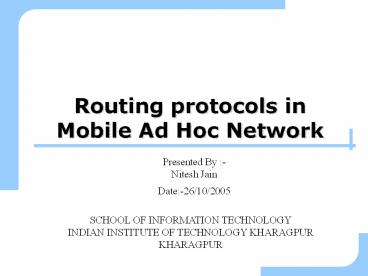Routing protocols in Mobile Ad Hoc Network - PowerPoint PPT Presentation
1 / 24
Title:
Routing protocols in Mobile Ad Hoc Network
Description:
NETwork) (MANET). Characteristics of an Ad-hoc network. Collection of mobile nodes forming a temporary network. Network topology changes frequently and ... – PowerPoint PPT presentation
Number of Views:896
Avg rating:3.0/5.0
Title: Routing protocols in Mobile Ad Hoc Network
1
Routing protocols in Mobile Ad Hoc Network
Presented By - Nitesh Jain Date-26/10/2005
SCHOOL OF INFORMATION TECHNOLOGY INDIAN INSTITUTE
OF TECHNOLOGY KHARAGPUR KHARAGPUR
2
Types of Wireless Networks
- Infrastructure based(Cellular Network).
- Infrastructureless Network(Mobile Ad hoc
- NETwork) (MANET).
3
Characteristics of an Ad-hoc network
- Collection of mobile nodes forming a temporary
network - Network topology changes frequently and
- unpredictably
- No centralized administration or standard
- support services
- Host is also function as router
4
Why is Routing Different in Ad Hoc ???
- Host mobility
- Dynamic topology
- link failure/repair due to mobility
- Distributed Environment
- Bandwidth constrained
- Energy constrained
5
Categorization of Ad-Hoc Routing Protocols
6
Table Driven Routing Protocol
- Proactive.
- Each node maintains one or more tables
- containing routing information to every other
- node in the network.
- Tables need to be consistent and up-to-date
- view of the network.
- Updates propagate through the network
7
Source Initiated On demand routing protocol
- Reactive.
- on-demand style create routes only when it is
desired by the source node - When a node requires a route to a destination,
- it initiates a route discovery process
- Route is maintained until destination becomes
unreachable, or source no longer is interested - in destination.
8
Table Driven Routing Protocol
9
Destination-Sequenced Distance Vector Protocol
(DSDV)
- Basic Routing Protocol
- Based on Bellman ford routing algorithm with some
- improvement
- Each node maintains a list of all destinations
and - number of hops to each destination.
- Each entry is marked with a sequence number.
- Periodically send table to all neighbors to
maintain - topology
- Two ways to update neighbors
- Full dump
- Incremental update
10
Example of DSDV
As Routing Table Before Change
As Routing Table After Change
11
Clusterhead Gateway Switch Routing (CGSR)
- Similar to DSDV
- Based on concept of clusters and cluster heads
- Routing is done via the cluster heads and
- gateways
- A routing table among cluster heads are
- maintained
12
Example of CGSR
- Data forwarding steps
- from cluster head to
- cluster head
- in a hierarchical manner
- then from cluster head to
- cluster members
- between two cluster heads,
- gateways are used to forward
- the packets
13
Source Initiated On demand routing protocol
14
Ad hoc On-demand Distance Vector Routing(AODV)
- Pure on-demand protocol
- Node does not need to maintain knowledge of
another - node unless it communicates with it
- AODV includes route discovery and route
maintenance. - AODV minimizes the number of broadcasts by
creating - routes on-demand
- AODV uses only symmetric links because the route
reply packet follows the reverse path of route
request packet - AODV uses hello messages to know its neighbors
and - to ensure symmetric links
15
Path discovery
- In the path discovery (RREQ) phase, source
broadcasts RREQ message. - Intermediate nodes record in their route tables
the address of neighbor from which RREQ is
received to establish a reverse path. - When RREQ reaches destination or an intermediate
node responds by unicasting a route reply (RREP)
back to neighbor.
16
Path maintenance
- If source node moves, reestablish the path.
- If destination or intermediate node moves, send
link failure notification message to each of its
active upstream. - Then reinitiate path discovery .
17
Dynamic Source Routing Protocol (DSR)
- on-demand
- A node maintains route cache containing the
- routes it knows
- Two main phases
- Route discovery
- Route maintenance
- Basic Operation is similar to AODV.
- Main difference
- To use routing cache for link failure.
- When route discovery phase, node send route
request message with its own address.
18
Example of DSR
19
Hybrid Routing Protocols
20
Zone Routing Protocol
- Hybrid of table-driven and on-demand!!
- From each node, there is a concept of zone.
- Within each zone, the routing is performed in a
- table-driven manner (proactive).
- However, a node does not try to keep global
- routing information.
- For inter-zone routing, on-demand routing is
- used.
21
Example of ZPR
- Three types of nodes
- Border Nodes
- Peripherals Nodes
- Interior Nodes
22
Comparison
23
References
- Elizabeth M. Royer, Chai-Keong Toh, A Review of
Current Routing Protocols for Ad Hoc Mobile
Wireless Networks,Proc. IEEE,1999. - David B. Johnson, " Routing in Ad hoc Networks of
Mobile Hosts", Proc - IEEE Workshop on Mobile Computing Systems and
Applications. - Nicklas Beijar Zone Routing Protocol .
- www.cse.wustl.edu/jain/cis788-99/adhoc_routing/
- http//www.comp.brad.ac.uk/sburuha1/index.htm
- www.computingunplugged.com/ issues/issue200407/000
01326001.html - http//www.ietf.org/rfc/rfc3561.txt
24
- THANKYOU
- ?










![[AD Hoc Networks] PowerPoint PPT Presentation](https://s3.amazonaws.com/images.powershow.com/8371435.th0.jpg?_=20161231113)




















